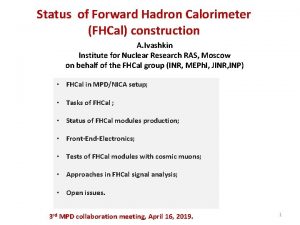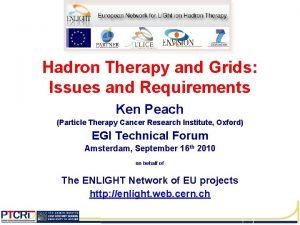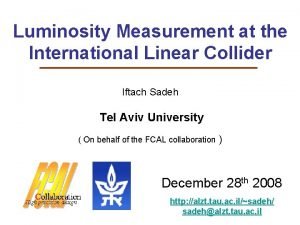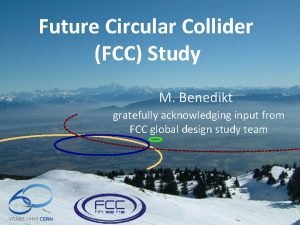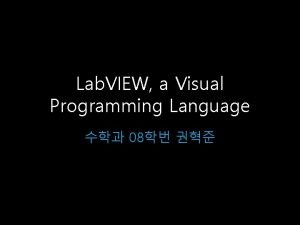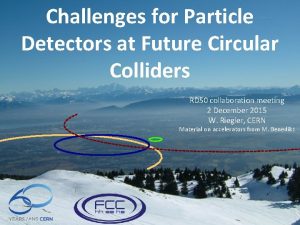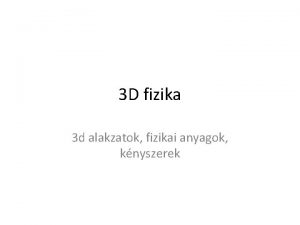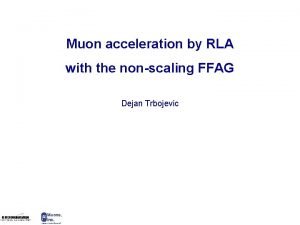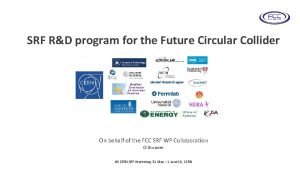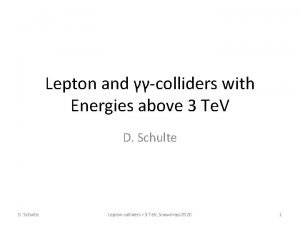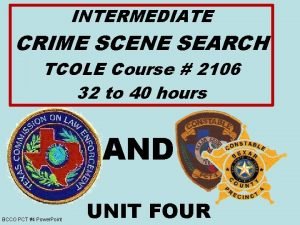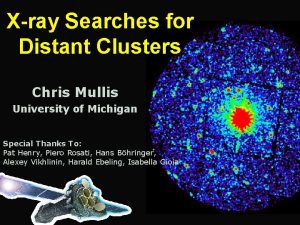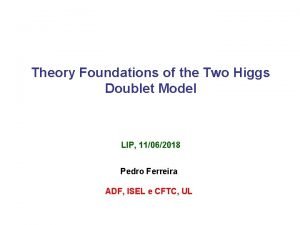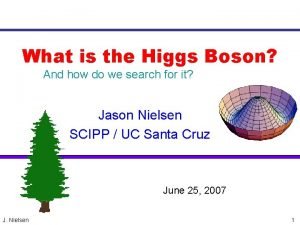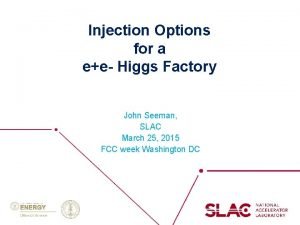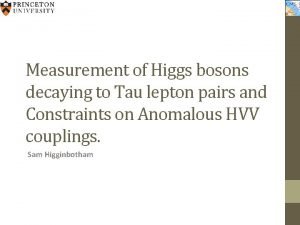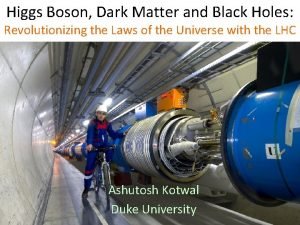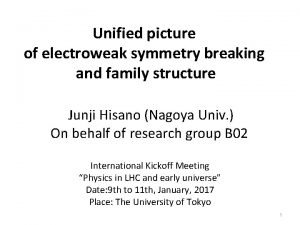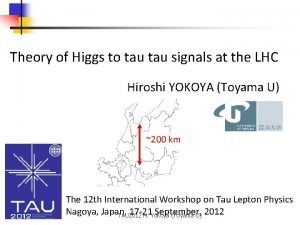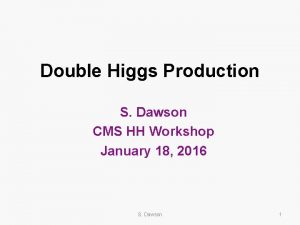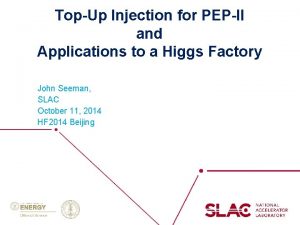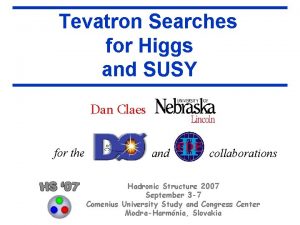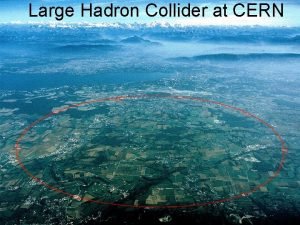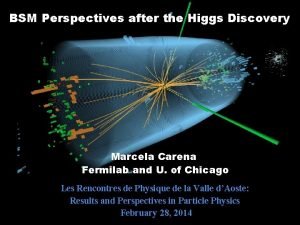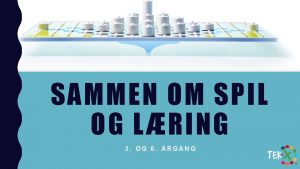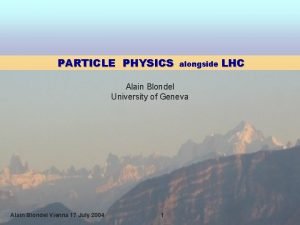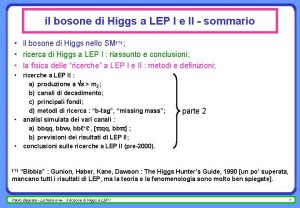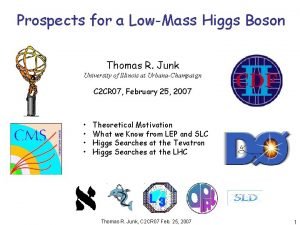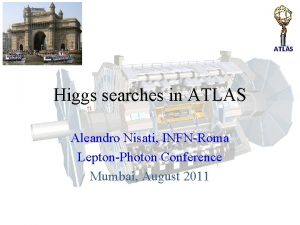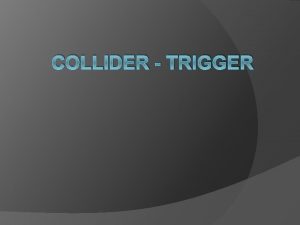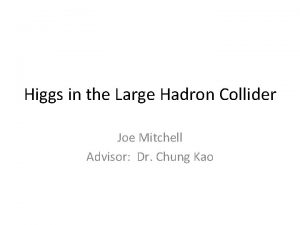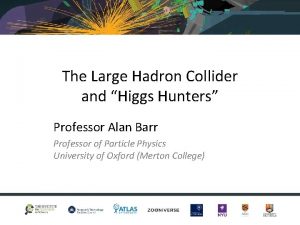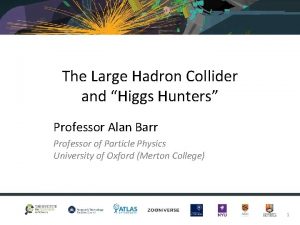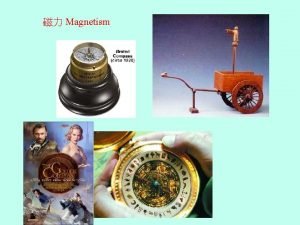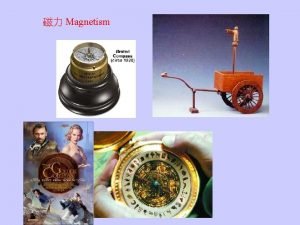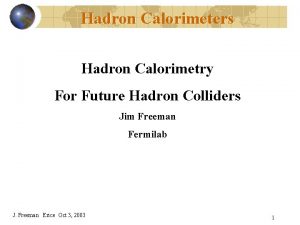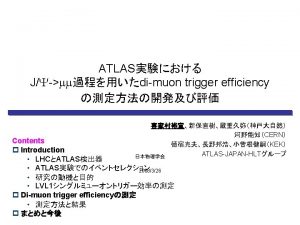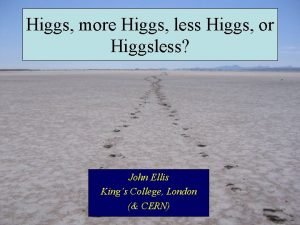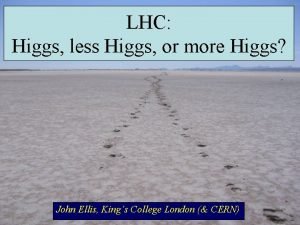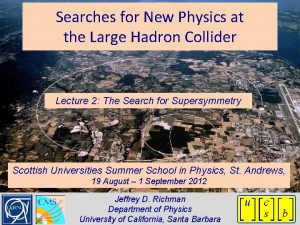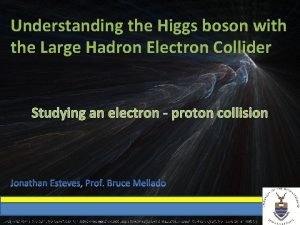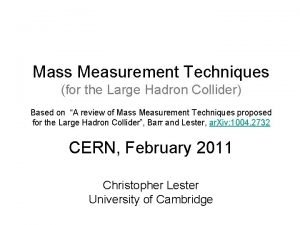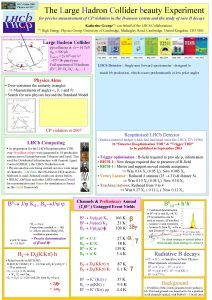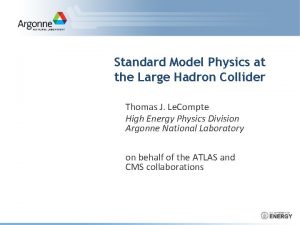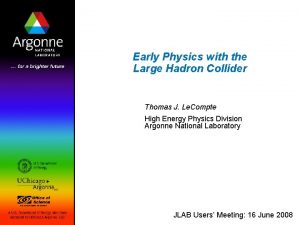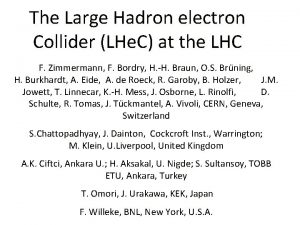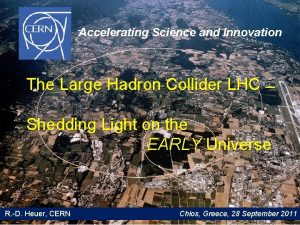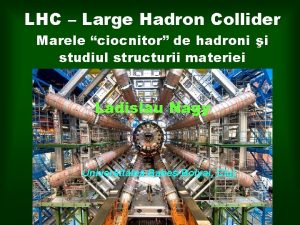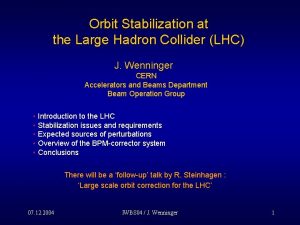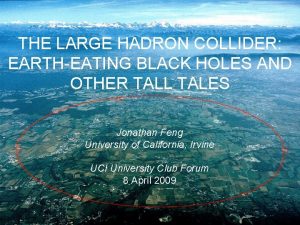Higgs searches at the Large Hadron Collider Aleandro




























































- Slides: 60

Higgs searches at the Large Hadron Collider Aleandro Nisati (INFN-Roma) CHIPP Engelberg, 22 -27 January 2012

index • Standard Model Higgs phenomenology: see lectures by Giulia Zanderighi • SM Higgs searches at LHC: – H γγ – H ττ, bb – H WW(*) – H ZZ(*) • Perspectives 1/22/11 A. Nisati, the first two years of physics at the LHC 2

Introduction • Higgs searches represent on of the most important themes of the LHC scientific programme • Higgs searches guided the conception design and technological choices of ATLAS and CMS • Among the most challenging physics processes, in particular in the mass region below m. H = 2 m. Z • high energy resolution and reconstruction+identification efficiency of leptons, jets, b-jets tagging, missing transverse energy, etc Proceedings of LHC Workshop (Aachen, 1990): H 4 l signals m. H=130, 150, 170 Ge. V √s = 16 Te. V, 100 fb-1 • After two years of operations, the situation is very exciting: • The LHC is working very well: more than 5 fb-1 of data/experiment delivered • The understanding of the detectors ATLAS and CMS is quite advanced A. Nisati, the first two years of physics at 1/22/11 3 the LHC

Higgs phenomenology Experimentally most sensitive channels vs m. H 125 -180 WW(*) lνlν <130 γγ 300 -600 ZZ llνν 125 -300 ZZ(*) llll • Cross-sections computed to NNLO in most cases theory uncertainties reduced to < 20% • Huge progress also in theoretical predictions of numerous and complex backgrounds • Excellent achievements of theory community; very fruitful discussions with the A. Nisati, the first two years of physics at 1/22/11 4 experiments (e. g. through LHC Higgs Cross Section WG, LPCC, etc. ) the LHC

The Higgs searches status at HCP 2011 November 2011 CMS PAS HIG-11 -023, ATLAS-CONF-201 -157 LEP (95%CL) m. H > 114. 4 Ge. V Tevatron exclusion (95%CL): 100 < m. H < 109 Ge. V 156 < m. H < 177 Ge. V First ATLAS+CMS combination: based on data recorded until end August 2011: up to ~2. 3 fb-1 per experiment Excluded 95% CL : 141 -476 Ge. V Excluded 99% CL : 146 -443 Ge. V (except ~222, 238 -248, ~295 Ge. V) Expected 95% CL 1/22/11 : 124 -520 Ge. VA. Nisati, maxthe deviation fromofbackground-only: ~ 3σ (m. H~144 Ge. V) first two years physics at the LHC 5

During the last few months of 2011… • ATLAS and CMS collaborations worked very hard to analyse the full 2011 datasets: – ATLAS: updated the most sensitive channels in the best motivated and not-yet excluded low mass region: H γγ (4. 9 fb-1); H ZZ(*) 4 l (4. 8 fb-1); H WW(*) lνlν (2. 1 fb-1); – CMS: updated all channels considered for physics analysis during last summer 1/22/11 A. Nisati, the first two years of physics at the LHC 6

Micro-summary of present Higgs searches in ATLAS q Based on (conservative) cut-based selections q Large and sometimes not well-known backgrounds estimated mostly with data-driven techniques using signal-free control regions

CMS Analyses All 8 analyses yielded a preliminary result to be shown today, and contributed to the CMS combination documented in HIG-011 -32. 1/22/11 A. Nisati, the first two years of physics at the LHC 8

H γγ – event selection • Very simple signature (and analysis) • Photon identification based both on lateral and longitudinal segmentation of the Electromagnetic calorimeter • Two high-quality isolated highp. T photons – p. T 1 > 40 Ge. V; p. T 2 > 25 Ge. V – |η 12| < 1. 37 and 1. 52 < |η 12| <2. 37 1/22/11 A. Nisati, the first two years of physics at the LHC ATLAS Sampling 3 Sampling 2 Sampling 1 preshower Spring 2011 data 9

H γγ – mass reconstruction ATLAS Mass reconstruction m 2 = 2 P 1 P 2(1 -cos ) P 1 P 2 2 dm/m = (1/ 2)(d. P/P) d / p 1 It is important to measure the photon momentum in space with high resolution: • accurate measurement of the photon energy • accurate measurement of the photon direction of flight q • CMS: • ATLAS: – – high energy resolution – – Measure the photon direction using the longitudinal segmentation of the LAr calorimeter, and fit the γγ production vertex using the pp beam line A. Nisati, the first two years of physics at 1/22/11 p 2 the LHC very high energy resolution Measure the photon direction using the impact point measured by the crystal calorimeter, and the hardscattering proton-proton vertex requires correct vertex identification in presence of large pile-up 10

H γγ – mass reconstruction ATLAS • Energy resolution contribution δp ≈ 1. 3 Ge. V – Energy scale calibration from Z e+e− • Interaction point spread: σ(z) ≈ 5. 6 cm δm (θ) ≈ 1. 4 Ge. V • Resolution with pointing: σ(z) ≈ 1. 5 cm; – Use of recoil tracks less effective with large number of pile-up collisions • Use conversion tracks as well 1/22/11 CMS: correct primary vertex reconstruction efficiency as a function of run (top table), and of the Higgs transverse momentum. Distribution of the simulated m. H = 120 Ge. V Higgs events ATLAS: Distribution of simulated m. H = 120 Ge. V Higgs events; σ(m) ~ 1. 7 Ge. V (using 2010 calibration) A. Nisati, the first two years of physics at the LHC 11

H γγ – results ATLAS • After all cuts: 22489 events with 100 < mγγ < 160 Ge. V observed in the data Background estimated with data control samples γj + jj << γγ irreducible (purity ~ 70%) 1/22/11 A. Nisati, the first two years of physics at the LHC 12

H γγ – results ATLAS Photon reconstruction efficiency: ~98% Photon identification efficiency: ~ 85± 5% from MC, cross-checked with data (Z ee, Z eeγ, μμγ) Signal efficiency: ~ 35% for m. H = 125 Ge. V • Divide the data in different categories, based on photon pseudorapidity, whether it is unconverted, and (ATLAS) the γγ transverse momentum with respect to the γγ thrust axis – Four categories for CMS – Nine categories for ATLAS 1/22/11 A. Nisati, the first two years of physics at the LHC 13

ATLAS H γγ – results • The background is measured both in ATLAS and CMS ATLAS: Main systematic uncertainties – ATLAS fits the full spectrum with a single exponential curve (evaluate systematics using a double exponential curve, or a Bernstein Expected signal yield : ~ 20% nd polynomial of 2 order) H γγ mass resolution : ~ 14% – CMS fits the full spectrum using a Bernstein H γγ p modeling : ~ 8% T polynomial of 5 th order (systematics Background modeling : ± 0. 1 -5. 6 events evaluated using four different analytical A. Nisati, the first two years of physics at 1/22/11 14 the LHC functions)

H γγ – results ATLAS: Systematic uncertainties on signal expectation • Signal modelling: – ATLAS describes the Higgs boson signal with the combination of a Crystal Ball function and a Gaussian function; – CMS describes the Higgs boson signal with similar analytical fit to MC events (unbinned analysis), or with MC templates (binned analysis) 1/22/11 A. Nisati, the first two years of physics at the LHC 15

ATLAS H γγ - exclusion limits ATLAS: Excluded (95% CL): 114 ≤ m. H ≤ 115 Ge. V, 135 ≤ m. H≤ 136 Ge. V 1/22/11 CMS: Excluded (95% CL): 127 ≤ m. H ≤ 131 Ge. V A. Nisati, the first two years of physics at the LHC 16

H γγ – excess study ATLAS Maximum deviation from background-only expectation observed for m. H~126 Ge. V: q local p 0 -value: 0. 27% (or 2. 8σ) q expected from SM Higgs: ~ 1. 4σ local q global p 0 -value: includes probability for such an excess to appear anywhere in the investigated mass range (110 -150 Ge. V) (“Look-Elsewhere-Effect”): ~7% (1. 5σ) 1/22/11 Maximum deviation from background-only expectation observed for m. H 123. 5 Ge. V: q local p 0 -value: ~1% (or 2. 3σ) q expected from SM Higgs: ~ 1. 4σ local q global p 0 -value: includes probability for such an excess to appear anywhere in the investigated mass range (110 -150 Ge. V) (“Look-Elsewhere-Effect”): ~21% (0. 8σ) A. Nisati, the first two years of physics at the LHC 17

H ZZ(*) 4 l • Small cross section × BR: σ×BR ~ 2 -5 fb • However: • mass can be fully reconstructed events would cluster in a (narrow) peak • large signal-to-background ratio: S/B ~ 1 • 4 leptons: p. T 1, 2, 3, 4 > 20, 7, 7 Ge. V; m 12 = m. Z ± 15 Ge. V; m 34 > 15 -60 Ge. V (depending on m. H) [ATLAS] • Main backgrounds: • ZZ(*) (irreducible) • m. H < 2 m. Z : Zbb, Z+jets, tt with two leptons from b/q-jets lepton • Suppressed with isolation and impact parameter cuts on two softest leptons • Signal acceptance x efficiency: ~ 15 % for m. H~ 125 Ge. V Crucial experimental aspects: q High lepton reconstruction and identification efficiency down to lowest p. T q Good lepton energy/momentum resolution q Good control of reducible backgrounds (Zbb, Z+jets, tt) in low-mass region: cannot rely on MC alone (theoretical uncertainties, b/q-jet l modeling, . . ) need to compare MC to data in background-enriched control regions (but: low statistics. . ) Conservative/stringent p. T and m(ll) cuts used at this stage 1/22/11 A. Nisati, the first two years of physics at the LHC 18

ATLAS: Electron performance Identification efficiency from J/ψ ee, W eν, Z ee data samples Systematic uncertainty: 6% (p. T~7 Ge. V) < 2 % (p. T~50 Ge. V) Crucial to understand low-p. T electrons (affected by material) with data Variation of electron efficiency with pile-up (cuts not re-tuned yet) well modeled by simulation: from Z ee data and MC samples H 4 e mass resolution: 2. 5 Ge. V Event fraction in ± 2σ: ~ 82% No Z-mass fit constraint 19

ATLAS Muon performance Muon (calorimetric) isolation efficiency from Z μμ events in data and MC Muon reconstruction efficiency > 95% over 4 < p < 100 Ge. V Improving Z μμ mass resolution No Z-mass fit constraint MC (perfect): 2. 31 ±. 01 Ge. V Data Spring 2011 : 2. 89 ±. 01 Ge. V Data Summer 2011: 2. 45 ±. 01 Ge. V H 4μ mass resolution: ~2 Ge. V Event fraction in ± 2σ: ~ 85% 20

H ZZ 4 e, 4μ, 2 e 2μ: The Golden Channel 4μ candidate PT 43 Ge. V PT 26 Ge. V PT 48 Ge. V PT 20 Ge. V 2μ 2 e candidate: mlead: 85. 9 Ge. V msubl: 85. 5 Ge. V m 4 l: 210 Ge. V

H ZZ(*) 4 l After all selections: kinematic cuts, isolation, impact parameter ATLAS: Full mass range Observed: 71 events: 24 4μ + 30 2 e 2μ + 17 4 e Expected from background: 62± 9 ATLAS: m(4 l) < 180 Ge. V Observed: 8 events: 3 4μ + 3 2 e 2μ + 2 4 e Expected from background: 9. 3± 1. 5 CMS: Full mass range Observed: 72 events: 23 4μ + 37 2 e 2μ + 12 4 e Expected from background: 67. 1± 6. 0 CMS: m(4 l) < 160 Ge. V Observed: 13 events: 5 4μ + 5 2 e 2μ + 3 4 e 1/22/11 A. Nisati, the first two years of physics at the LHC Expected from background: 22 9. 5± 1. 3

H ZZ(*) 4 l After all selections: kinematic cuts, isolation, impact parameter ATLAS: In the region m. H < 141 Ge. V (not already excluded at 95% C. L. ) 3 events are observed: two 2 e 2μ events (m=123. 6 Ge. V, m=124. 3 Ge. V) and one 4μ event (m=124. 6 Ge. V) In the region 117< m 4 l <128 Ge. V (containing ~90% of a m. H=125 Ge. V signal): • similar contributions expected from signal and background: ~ 1. 5 events each • Background dominated by ZZ* (4μ and 2 e 2μ), ZZ* and Z+jets (4 e) • Background dominated by ZZ* (4μ and 2 e 2μ), ZZ* and Z=jets (4 e) CMS: In the region m. H < 141 Ge. V (not already excluded at 95% C. L. ) 9 events are observed. 1/22/11 A. Nisati, the first two years of physics at the LHC 23

95% C. L Exclusion Limits ATLAS Observed Excluded range 135 < m. H < 156 Ge. V, 181 < m. H < 415 Ge. V (except 234 -255 Ge. V) Expected excluded range: 137 < m. H < 158 Ge. V 185 < m. H < 400 Ge. V CMS Expected excluded range: 130 < MH < 160 Ge. V; 182 < MH < 420 Ge. V Observed excluded range: 134 < MH < 158 Ge. V; 180 < MH < 305 Ge. V; 340 < MH < 460 Ge. V 1/22/11 A. Nisati, the first two years of physics at the LHC 24

H WW(*) lνlν • The most sensitive process for 130 < m. H < 200 Ge. V • But also one of the most challenging channels: complete reconstruction of the invariant mass of this final system is not possible • Largest background is the irreducible WW SM production – But also Drell-Yan and top process when looking to final states associated to one jet • Select events with two high-p. T opposite sign leptons and large transverse missing energy (ETmiss) ATLAS 1/22/11 ATLAS analysis cuts e-e μ-μ e-μ p. T leading, Ge. V 25 25 25 p. T subleading, Ge. V 20 15 e: 15, μ: 20 ETmissrel 40 40 25 A. Nisati, the first two years of physics at the LHC 25

H WW(*) lνlν • After ETmissrel cut, divide the events in two categories: 1. Events with 1 jet with p. T>25 Ge. V and |η|<4. 5; 2. Events with no jets • Apply topological cuts (mll, p. Tll, Δφll) • Reconstruct the transverse mass m. T and apply the cut 0. 75×m. H<m. T<m. H ATLAS 1/22/11 A. Nisati, the first two years of physics at the LHC 26

H WW(*) lνlν ATLAS Distributions of mll (left), Δϕll (center), and m. T (right). The top row shows the selection for the H+0 -jet channel and the bottom row for the H+1 -jet channel. The left and central plots are shown after the p. Tll selection for the H+0 -jet channel and after the p. Ttot cut for the $H+1 -jet channel. For the rightmost plots, the distributions are shown after all the cuts for m. H=150 Ge. V (except the cut on m. T itself). The background distributions are stacked, so that the top of the diboson background coincides with the Standard Model (SM) line which includes the statistical and systematic uncertainties on the expectation in the absence of a signal. The expected signal for m. H=150 Ge. V is shown as a separate thicker line, and the final bin includes the overflow. 1/22/11 A. Nisati, the first two years of physics at the LHC 27

H WW(*) lνlν ATLAS Final selection, optimized for m. H=150 Ge. V WW ttbar Total SM back. Data Higgs 0 -jet 52± 7 2. 4± 1. 6 63± 9 81 40± 9 1 -jet 12± 3 8± 2 28± 4 29 14± 3 m. H=150 Event yield after full selection, in data and MC (W+jets estimated with data driven methods). The cuts are here optimized to select m. H=150 Ge. V Higgs decays. • Background estimate from data in counting experiment is essential • In the current version of this analysis we estimate from data the two largest backgrounds, namely those from WW and top – Approach: • Define control regions rich in WW or top backgrounds and measure this backgrounds in data • Extrapolate this measurement to the signal region(s) using MC shapes • W+ jets entirely determined from data • Remaining backgrounds (smaller) are taken from MC – Apply scale factor to Drell-Yan for potential ETmiss mis-modelling 1/22/11 A. Nisati, the first two years of physics at the LHC 28

H WW(*) lνlν ATLAS exclusion limits Expected range: 134 < MH < 200 Ge. V Observed range: 145 < MH < 206 Ge. V 1/22/11 CMS exclusion limits – CMS results are based on a multivariate analysis (Boosted Decision Tree) Expected range: 129 < MH < 236 Ge. V Observed range: 132< MH < 238 Ge. V A. Nisati, the first two years of physics at the LHC 29

H ττ • Promising channel for SM Higgs searches in the mass range m. H=110 -140 Ge. V – The VBF production offer the advantage of a small background, at the price of a low signal production rate • Three classes of final states, depending on the τdecay: – – – lepton-lepton, ll lepton-hadron, lh hadron-hadron, hh ATLAS studied the ll and lh final states CMS studied the lh and the e-μ final states Collinear approximation • Most important backgrounds: – Z/γ* ll + jets ( ττ is largely irreducible); W lυ + jets; dibosons, ttbar and single top, QCD jets • ll finale state: reconstruct the tau momentum in the collinear approximation • Apply dilepton invariant mass and topological cuts • Study the tau-tau invariant A. Nisati, mass the first two years of physics at 1/22/11 the LHC 30

0 or 1 JET 0 jets>30 Ge. V or 1 jet<150 Ge. V BOOSTED One jet PT>150 Ge. V Example of data in VBF Channels: : presence of tagging jets suppresses backgrounds. VBF >= 2 jets >30 Ge. V Dh>4, Mjj>400 Ge. V No additional jets with PT>30 Ge. V In the rapidity gap ATLAS has analyzed till 1. 04 fb-1 of data, with results consistent with those from CMS (taking into account the integrated luminosity). This channel is approaching the sensitivity to the SM Higgs production 1/22/11 A. Nisati, the first two years of physics at the LHC 31

H bb 5 sub channels Z( ll); H bb, l = μ, e W( ln) ; H bb, l = μ, e Z( nn); H bb Analysis method largely unchanged w. r. t LP’ 11 Extensive use of data driven methods to control the backgrounds. • • gg H bb and VBF are dominant production modes but overwhelmed by enormous QCD di-jet background Best option: qq VH; H bb – Major backgrounds are V+jets, VV, ttbar • Use – – VH topology : ΔΦ(V, H) > 3 PT(V)> 100 -160 Ge. V (boosted W/Z) Tight b-tagging & MET quality Backgrounds estimated from control data 1/22/11 A. Nisati, the first two years of physics at the LHC 32

H ZZ llνν • Final state characterized by the production of a Z in leptons accompained by large transverse missing energy, it offers a significant branching fraction in combination with a good separation from background processes • Main background: reducible QCD W/Z+jets, top; irreducible WW, WZ, ZZ • Select events with two same-flavour opposite charge leptons whose invariant mass is consistent with the Z-mass, and ETmiss > 66(82) Ge. V (ATLAS) depending on the “low’(“high”) mass analysis – Apply also topological cuts to suppress W/Z+jet QCD background • Finally, study the transverse mass distribution, m. T: 1/22/11 A. Nisati, the first two years of physics at the LHC 33

H ZZ llνν Left: Etmiss distribution after the mll window cut. Right: the dilepton transverse mass distribution of selected candidate events; MT shape ATLAS • ATLAS: The observed limit is slightly lower and a Standard Model Higgs boson in the range 350 Ge. V < m. H < 450 Ge. V, can be excluded at the 95% confidence level. • CMS: 95%CL exclusion limits for a SM Higgs boson in A. Nisati, the first two years of physics at 1/22/11 the range 270 -440 Ge. V (MT shape based analysis) the LHC 34

H ZZ llqq • Very helpful channel in the Higgs mass range m. H > 2 m. Z, with acceptable signal-to-background ratio • Signature: Z ll+2 jets final states • Main backgrounds: QCD Z+jets • Event selection (ATLAS): – Same flavour pair of isolated leptons with p. T>20 Ge. V, with 76 <mll<106 Ge. V Jet: 207 Ge. V e: 177 Ge. V • Third lepton veto, ETmiss<50 Ge. V – ≥ 2 jets p. T>25 Ge. V |η|<2. 5, with 70 <mll<105 Ge. V – Reconstruct the final state invariant mass mlljj (with mjj scaled to m. Z) 1/22/11 A. Nisati, the first two years of physics at the LHC Jet: 114 Ge. V e: 114 Ge. V M 2 l 2 j = 580 Ge. V 35

H ZZ llqq The invariant mass of the lljj system for the buntagged (left) and b-tagged (right) selections, for m. H = 200 and 400 Ge. V. The Higgs boson signal in the untagged plots has been scaled up by a factor of 10. ATLAS Very helpful channel in the Higgs mass range m. H > 2 m. Z, with acceptable signal-tobackground ratio Signature: Z ll+2 jets final states: • Reconstruct a Z ll, a second Z jj; • Reconstruct then the final state invariant mass mlljj (with mjj scaled to m. Z) 1/22/11 A. Nisati, the first two years of physics at the LHC 36

Overall ATLAS Higgs Combination H γγ, H ττ H WW(*) lνlν H ZZ(*) 4 l, H ZZ llνν H ZZ llqq, H WW lνqq W/ZH lbb+X not included LEP ATLAS+CMS Combination ATLAS today 95% C. L. exclusion limits: Obs: 112. 7 -115. 5 Ge. V and 131 -453 Ge. V except 237 -251 Ge. V exp: 124. 6 -520 Ge. V Excluded at 99% CL : 133 <m. H < 230 Ge. V, 260 < m. H < 437 Ge. V 1/22/11 A. Nisati, the first two years of physics at the LHC 37

Overall ATLAS Higgs Combination Maximum deviation from background-only expectation observed for m. H~126 Ge. V Local p 0 -value: 1. 9 10 -4 local significance of the excess: 3. 6σ ~ 2. 8σ H γγ, 2. 1σ H 4 l, 1. 4σ H lνlν Expected from SM Higgs: ~2. 4σ local (~1. 4σ per channel) 1/22/11 Global p 0 -value : 0. 6% 2. 5σ LEE over 110 -146 Ge. V A. Nisati, the first two years of physics at Global p 0 -value : 1. 4% 2. 2σ LEE over 110 -600 Ge. V the LHC 38

Compatibility of the observation with the expected strength of a SM Higgs signal Total H γγ H lνlν H 4 l The observed excess is slightly A. larger (2± 0. 8) Nisati, the first twothan years ofexpected physics at in the H γγ channel 1/22/11 the LHC and compatible within 1σ for the other channels and the combined result 39

Overall CMS Higgs Combination CMS Expected limit in case of no SM Higgs boson, with L~4. 7 fb-1 of data Very close or better than 1 x. SM in the full mass range. Optimization of some analyses still ongoing. Additional sub-channels under study. 1/22/11 A. Nisati, the first two years of physics at the LHC 40

Overall CMS Higgs Combination 95%CL: obs 127 -600, exp: 117 -543 Ge. V 1/22/11 A. Nisati, the first two years of physics at the LHC 41

Overall CMS Higgs Combination The excess at low mass is produced by a broad excess driven by the low resolution channels (H 2 TT, H 2 WW, H 2 BB, center), modulated by the localized excesses seen by the high resolution channels (H 2 GG and H 2 ZZ, right). 1/22/11 A. Nisati, the first two years of physics at the LHC 42

Overall CMS Higgs Combination The excess at low mass is produced by a broad excess driven by the low resolution channels (H 2 TT, H 2 WW, H 2 BB, center), modulated by the localized excesses seen by the high resolution channels (H 2 GG and H 2 ZZ, right). 1/22/11 A. Nisati, the first two years of physics at the LHC 43

Overall CMS Higgs Combination The excess at low mass is produced by a broad excess driven by the low resolution channels (H 2 TT, H 2 WW, H 2 BB, center), modulated by the localized excesses seen by the high resolution channels (H 2 GG and H 2 ZZ, right). 1/22/11 A. Nisati, the first two years of physics at the LHC 44

Overall CMS Higgs Combination The excess at low mass is produced by a broad excess driven by the low resolution channels (H 2 TT, H 2 WW, H 2 BB, center), modulated by the localized excesses seen by the high resolution channels (H 2 GG and H 2 ZZ, right). We cannot exclude the presence of the SM Higgs boson below 127 Ge. V because of a modest excess of events in the region between 115 and 127 Ge. V. A. Nisati, the first two years of physics at 1/22/11 45 the LHC

Overall CMS Higgs Combination Maximum local significance 2. 6 s. LEE-corrected significance (full mass range: 110 -600 Ge. V)= 0. 6 s LEE-corrected significance (low mass range: 110 -145 Ge. V)= 1. 9 s The excess we see in the low mass region has a modest statistical significance and could be reasonably a fluctuation of the background. 1/22/11 A. Nisati, the first two years of physics at the LHC 46

perspectives Lepton-Photon 2011 • Take and analyze more data – Further improve/optimize the analysis, where still possible • Scrutinize the mass intervals that will be further excluded by data under the assumption of the existence of a SM Higgs boson • Scrutinize the mass intervals that will (still) show event excess(es), and the associated significance for the individual channels, and for the overall combination • Further produce lots of tests and cross-checks to ensure this excess is physics (as opposed to systematics effects detectorrelated) 1/22/11 • If a genuine physics excess will be observed with high significance then a new phase of our research at the LHC opens up: understand what it is, i. e. measure the physics properties associated to the resonance A. Nisati, the first two years of physics at the LHC 47

Short summary of MSSM Higgs results 1/22/11 A. Nisati, the first two years of physics at the LHC 48

Search for A/H ττ • The production of neutral Higgs bosons A/H is enhanced at large tanβ in the MSSM • Three classes of final states, depending on the τ-decay: – (lepton-lepton) eνν μνν – lepton-hadron, eνντhad μνντhad – hadron-hadron, ντhad • Good τ identification required, mττ reconstructed via visible mass or using the missing mass calculation technique 1/22/11 A. Nisati, the first two years of physics at the LHC 49

Search for A/H ττ • Expected and observed exclusion limits in the MSSM (m. A – tanβ) plane • mh max scenario 1/22/11 A. Nisati, the first two years of physics at the LHC 50

Search for a fermiophobic Higgs • Consider the following benchmark scenario: – all fermion couplings set to 0 – bosonic couplings kept at the SM values • modified Higgs production and decay branching ratios, e. g. no contributions from the gluon-fusion and tt. H associated production modes • VBF production mechanism becomes important higher transverse momentum due to recoiling jets or vector bosons 1/22/11 A. Nisati, the first two years of physics at the LHC 51

Search for a fermiophobic Higgs Background fits to the diphoton invariant mass spectra for the three p. T categories. The signal expectation for a Higgs boson with a mass of 115 Ge. V on top of the background fit is also shown. • Excluded mass regions: 110 – 111 Ge. V and 113. 5 – 117. 5 Ge. V • Expected exclusion: 110 – 116 Ge. V 1/22/11 A. Nisati, the first two years of physics at the LHC 52

MSSM H+ τν • MSSM has 5 Higgs bosons (CP even h and H; CP odd A; H+; H−) • If lighter than top quark, the charged Higgs is produced dominantly through top decays • With tanβ > 3, prefer to decay to τν final states τ + jets μ+τ e+μ • Three channels analysed by CMS 1/22/11 A. Nisati, the first two years of physics at the LHC 53

MSSM H+ τν • Select events with electrons, muons, hadronic taus and missing transverse energy, as well as jets b-tagged • Excluding BR(t → b. H) ~5% 80 < m. H+ < 160 Ge. V, a ssuming Br(H+ → τν)=1 • Similar results from ATLAS 1/22/11 A. Nisati, the first two years of physics at the LHC 54

Backup 1/22/11 A. Nisati, the first two years of physics at the LHC 55

Improvements in the H gg analysis • • – Vertex ID uses BDT • Improved vertex identification (gain 3%) – Progressive (“sliding”) cuts on photon p. T • p. T 1 > mγγ/3, p. T 2 > mγγ/4 – Cluster energy corrections + new intercalibrations+new transparency corrections – using the lasers. • Improved energy resolution – p. Tγγ event classification dropped for SM analysis • Remove threshold shaping of mass spectrum In order to take advantage of – The better signal over background ratio in the central part of the detector – The better resolution for central/unconverted photons The analysis is performed simultaneously in 4 categories (R 9 is a metric of the shower transverse size: R 9 = E 3 x 3 array / Esuper-cluster. It discriminates unconverted from converted photons) – Both photons in the Barrel, min(R 9) > 0. 94 – Both photons in the Barrel, min(R 9) < 0. 94 – At least one photon in Endcap, min(R 9) > 0. 94 – At least one photon in Endcap, min(R 9) < 0. 94 Better parameterization of background shape. 1/22/11 A. Nisati, the first two years of physics at the LHC 56

Improvements in Vertex Finding efficiency • Training BDT using input variables computed from – Track momenta – Photon kinematics • BDT improves correct vertex selection efficiency by 3% with respect to ranking algorithm used in EPS/LP analyses. • ‘Correct vertex’ is defined as being within 10 mm of true vertex z position • Vertex finding efficiency – From Z μm and g+ jets – Photon Selection efficiency – From Z ee 1/22/11 A. Nisati, the first two years of physics at the LHC 57

Photon identification efficiency: ~ 85± 5% from MC, cross-checked with data (Z ee, Z eeγ, μμγ) Photon isolation requirement: ET < 5 Ge. V inside a cone ΔR < 0. 4 around γ direction. Underlying event and pile-up contribution subtracted using an “ambient energy density” determined event-by-event. If the subtraction is not perfect, a residual dependence of the corrected isolation energy on the bunch position in the train is observed, due to the impact of pile-up from neighbouring bunches convolved with the LAr calorimeter pulse shape. Beginning of the train: no cancellation from previous bunches Calorimeter bipolar pulse shape: average pile-up is zero over ~ 600 ns (~12 bunches) Effect well described by the (detailed !) ATLAS simulation From 12 bunches inside the train: full cancellation

After all selections: kinematic cuts, γ identification and isolation q 22489 events with 100 < mγγ < 160 Ge. V observed in the data q expected signal efficiency: ~ 35% for m. H=125 Ge. V mγγ spectrum fit with exponential function for background plus Crystal Ball + Gaussian for signal background determined directly from data Systematic uncertainties on signal expectation Main systematic uncertainties Expected signal yield : ~ 20% H γγ mass resolution : ~ 14% H γγ p. T modeling : ~ 8% 59 Background modeling : ± 0. 1 -5. 6 events

Consistency of the data with the background-only expectation Maximum deviations from background-only expectations m. H (Ge. V) Local (global) p 0 Local significance Expected from SM Higgs Excluded at 95% C. L. by ATLAS+CMS combination 125 244 500 1. 8% (~50%) 2. 1 σ 1. 1% (~50%) 2. 3 σ 1. 4% (~50%) 2. 2 σ LEE estimated over mass range: 110 -600 Ge. V 1. 4σ 3. 2σ 1. 5σ
 Hadron collider
Hadron collider Hadron collider
Hadron collider Hadron calorimeter
Hadron calorimeter Hadron
Hadron Hadron
Hadron International linear collider
International linear collider Fcc collider
Fcc collider Language
Language Fcc collider
Fcc collider Unity sphere collider
Unity sphere collider Muon collider
Muon collider Martinello colider
Martinello colider Muon collider
Muon collider 2711 se loop 410 south
2711 se loop 410 south Xray searches
Xray searches Weinberg salam theory
Weinberg salam theory Higgs boson
Higgs boson Higgs factory
Higgs factory Higgs
Higgs Higgs boson black hole
Higgs boson black hole Higgs singlet
Higgs singlet Higgs to tau tau
Higgs to tau tau Higgs singlet
Higgs singlet Chelsea higgs wise
Chelsea higgs wise Higgs factory
Higgs factory Higgs
Higgs Playfer
Playfer Higgs singlet
Higgs singlet Hungry higgs brætspil
Hungry higgs brætspil Higgs factory
Higgs factory Bosone di higgs
Bosone di higgs Higgs boson
Higgs boson Diễn thế sinh thái là
Diễn thế sinh thái là đại từ thay thế
đại từ thay thế Vẽ hình chiếu vuông góc của vật thể sau
Vẽ hình chiếu vuông góc của vật thể sau Công thức tính độ biến thiên đông lượng
Công thức tính độ biến thiên đông lượng Làm thế nào để 102-1=99
Làm thế nào để 102-1=99 Tỉ lệ cơ thể trẻ em
Tỉ lệ cơ thể trẻ em Thế nào là mạng điện lắp đặt kiểu nổi
Thế nào là mạng điện lắp đặt kiểu nổi Lời thề hippocrates
Lời thề hippocrates Vẽ hình chiếu đứng bằng cạnh của vật thể
Vẽ hình chiếu đứng bằng cạnh của vật thể Quá trình desamine hóa có thể tạo ra
Quá trình desamine hóa có thể tạo ra Các môn thể thao bắt đầu bằng từ đua
Các môn thể thao bắt đầu bằng từ đua Hình ảnh bộ gõ cơ thể búng tay
Hình ảnh bộ gõ cơ thể búng tay Sự nuôi và dạy con của hươu
Sự nuôi và dạy con của hươu Các loại đột biến cấu trúc nhiễm sắc thể
Các loại đột biến cấu trúc nhiễm sắc thể Biện pháp chống mỏi cơ
Biện pháp chống mỏi cơ độ dài liên kết
độ dài liên kết Trời xanh đây là của chúng ta thể thơ
Trời xanh đây là của chúng ta thể thơ Chó sói
Chó sói Thiếu nhi thế giới liên hoan
Thiếu nhi thế giới liên hoan điện thế nghỉ
điện thế nghỉ Phối cảnh
Phối cảnh Một số thể thơ truyền thống
Một số thể thơ truyền thống Thế nào là hệ số cao nhất
Thế nào là hệ số cao nhất Slidetodoc
Slidetodoc Sơ đồ cơ thể người
Sơ đồ cơ thể người Số nguyên là gì
Số nguyên là gì đặc điểm cơ thể của người tối cổ
đặc điểm cơ thể của người tối cổ Các châu lục và đại dương trên thế giới
Các châu lục và đại dương trên thế giới Mật thư anh em như thể tay chân
Mật thư anh em như thể tay chân


